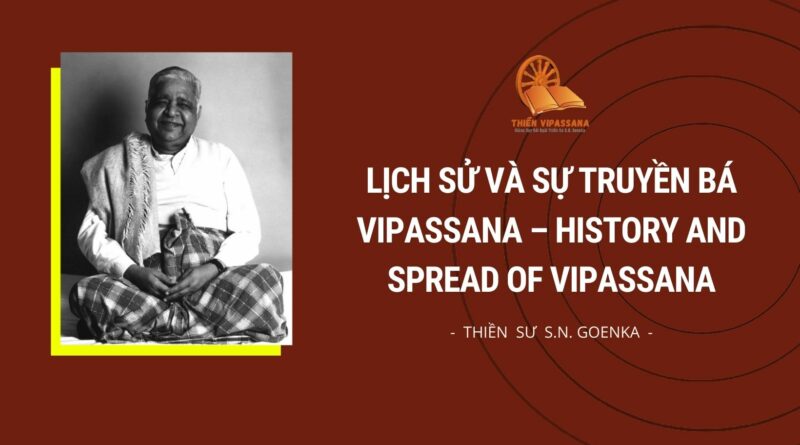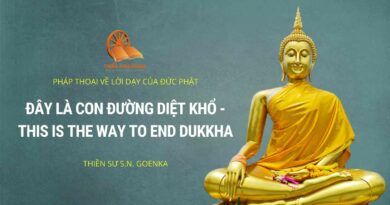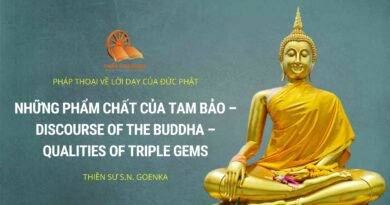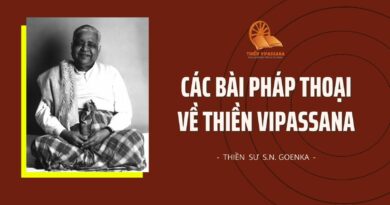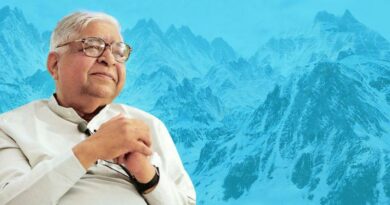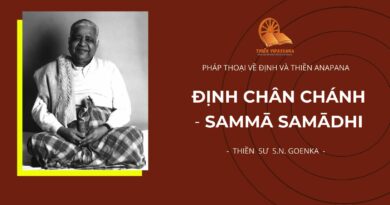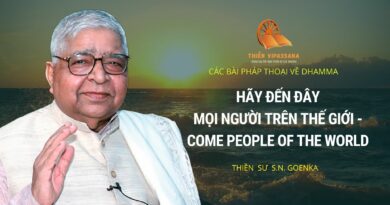History and Spread of Vipassana – Lịch sử và sự truyền bá Vipassana
Spread of Vipassana in Ancient Times – Sự truyền bá Vipassana ở thời cổ xưa
चरथ, भिक्खवे, चारिकं बहुजनहिताय बहुजनसुखाय लोकानुकम्पाय अत्थाय हिताय सुखाय देवमनुस्सानं। मा एकेन द्वे अगमित्थ। देसेथ, भिक्खवे, धम्मं आदिकल्याणं मज्झेकल्याणं परियोसानकल्याणं सात्थं सब्यञ्जनं केवलपरिपुण्णं परिसुद्धं ब्रह्मचरियं पकासेथ। सन्ति सत्ता अप्परजक्खजातिका, अस्सवनता धम्मस्स परिहायन्ति। भविस्सन्ति धम्मस्स अञ्ञातारो।”
-Go your ways, oh monks! for the benefit and happiness of many, out of compassion for the world, for the good, benefit, and happiness of gods and men. Let no two go in the same direction. Teach, oh monks, the Dhamma, which is beneficial in the beginning, in the middle, and at the end – both the spirit and the letter of it. Make known the Noble Life, which is fully complete (requiring no addition) and pure (requiring no subtraction). There are beings with only a little dust in their eyes who will be lost unless they hear the Dhamma. Such persons will understand the truth.”-Dutiyā Mārapāsa Sutta, Saṃyutta Nikāya, IV (I).5
-Hãy lên đường, các tỳ kheo! vì lợi lạc và hạnh phúc của nhiều người, từ bi với thế giới, vì lợi ích, lợi ích và hạnh phúc của các chư thiên và con người. Không để hai người đi chung một hướng. Hãy dạy Dhamma, hỡi các tỳ kheo, Dhamma, có lợi ở đầu, ở giữa và cuối – cả tinh thần và chữ chữ. Hãy làm cho Cuộc Sống cao quý, hoàn thành đầy đủ (không thêm vào) và thanh tịnh (không bớt đi). Có những người chỉ bị một chút bụi nhỏ trong mắt họ sẽ bị lạc đường trừ khi họ nghe thấy Dhamma. Những người như vậy sẽ hiểu được sự thật. “- Dutiyā Mārapāsa Sutta, Saṃyutta Nikāya, IV (I) .5
With these inspiring words, the Buddha exhorted his first 60 fully liberated (arahant) disciples, to go in different directions, with loving compassion, to teach Vipassana for the benefit of many, for the welfare of many. The Buddha himself compassionately distributed Dhamma throughout northern India, attracting a large number of people.
Với những lời truyền cảm hứng này, Đức Phật đã khích lệ 60 đệ tử đầu tiên những người đã giải thoát hoàn toàn (arahant), đi theo hướng khác nhau, với lòng từ bi yêu thương, để dạy Vipassana vì lợi ích của nhiều người, vì phúc lợi của nhiều người. Chính Đức Phật từ bi đã phân phát Dhamma khắp miền bắc Ấn Độ, thu hút số đông người dân.
Even Kings like Bimbisāra, Suddhodana, and Prasenajita received great benefit from their practice of the Dhamma and enthusiastically supported the dissemination of the Buddha’s teaching in their respective kingdoms. Yet the fact remains that the Vipassana spread to the masses not only because of this royal patronage but because of the efficacy of the technique itself.
Ngay cả các vị vua như Bimbisāra, Suddhodana và Prasenajita cũng nhận được lợi lạc to lớn từ việc thực hành Dhamma và nhiệt tình ủng hộ phổ biến Dhamma của Đức Phật trong vương quốc của họ. Tuy nhiên, sự thật vẫn là Vipassana lan tỏa đến đại chúng không chỉ vì sự bảo trợ của hoàng gia này mà còn vì hiệu quả của chính kỹ thuật này.
Emperor Asoka – Hoàng đế Asoka
Two centuries after the Buddha breathed his last, Emperor Asoka, horrified by the bloodshed and sorrow he caused by waging a war against Kalinga, the modern-day Indian state of Orissa, resolved to solemnly renounce the sword and to follow the path shown by the Buddha. After practising Vipassana, ‘fierce Asoka’ got transformed into ‘Dhamma Asoka’ and was instrumental in spread of Vipassana in India and abroad.
Hai thế kỷ sau khi Đức Phật trút hơi thở cuối cùng, Hoàng đế Asoka, gây khiếp sợ vì đã nhuộm máu và đau thương mà ông đã gây ra khi tiến hành một cuộc chiến chống lại Kalinga, thuộc bang Orissa của Ấn Độ thời hiện đại, đã quyết tâm từ bỏ thanh kiếm và đi theo con đường được Đức Phật chỉ dạy. Sau khi thực hành Vipassana, ‘Asoka tàn bạo’ đã biến thành ‘Dhamma Asoka’ và là cầu nối truyền bá Vipassana ở Ấn Độ và nước ngoài.
He established cetiyas, or memorials to the Buddha, throughout the length and breadth of his empire, for the teaching of the Dhamma. Out of compassion, he initiated Vipassana teaching in prisons, for the benefit of prison inmates.
Ông đã thành lập cetiyas, hay đài tưởng niệm Đức Phật, trong suốt chiều dài và chiều rộng của đế chế của mình, để giảng dạy Dhamma. Với lòng từ bi, ông đã khởi xướng việc dạy Vipassana trong các nhà tù, vì lợi ích của các tù nhân.
Under Asoka’s patronage, fully liberated arahant monks were sent out of northern India to nine different areas to make the Dhamma available to more people. These monks were called Dhamma dūtas (Dhamma messengers). They naturally gave emphasis to the practical aspect of the Dhamma by which they themselves had become free from mental impurities. Filled with love and compassion, they attracted large numbers of people to the path of liberation.
Dưới sự bảo trợ của Asoka, các vị arahant người đã giải thoát hoàn toàn đã được đi đến nhiều nơi ngoài miền bắc Ấn đến chín vùng đất khác nhau để truyền Dhamma cho nhiều người hơn. Những nhà sư này được gọi là Dhamma dūtas (sứ giả của Dhamma). Họ tự nhấn mạnh vào khía cạnh thực tế của Dhamma theo các tự nhiên mà chính họ đã trở nên tự do khỏi những bất tịnh tinh thần. Tràn đầy tình yêu và lòng từ bi, họ đã thu hút một lượng lớn người đến con đường giải thoát.
Asoka also sent teachers to as far away as present day Syria and Egypt. He paved the way for coming generations to spread Dhamma to the entire world. His lead was followed by King Kaniśhka who sent teachers to Central Asia and China. From there, Dhamma spread to Korea in the early 4th century AD, and then to Japan. In India, Dhamma Universities—Takkasilā, Nālandā, Vikkamasilā, and others developed, flourished, and attracted learned people from as far away as China. Dhamma also spread throughout South-east Asia.
Asoka cũng đã gửi các vị ấy đến tận Syria và Ai Cập ngày nay. Ông đã mở đường cho các thế hệ kế tiếp truyền bá Dhamma ra toàn thế giới. Dẫn đầu là vua Kaniśhka, người đã gửi các vị thầy đến Trung Á và Trung Quốc. Từ đó, Dhamma lan sang Hàn Quốc vào đầu thế kỷ thứ 4 sau Công nguyên, rồi sang Nhật Bản. Ở Ấn Độ, các trường đại học Dhamma, Takkasilā, Nālandā, Vikkamasilā, và những nơi khác đã phát triển khác, lớn mạnh và thu hút những học giả từ những nơi xa như Trung Quốc. Dhamma cũng lan rộng khắp Đông Nam Á.
Large numbers of people started practicing Vipassana in Thailand, Cambodia, Laos, Vietnam, and Indonesia. Tibet also received the Dhamma, through the service of Śāntirakshita, Padmasambhava, Atiśha, and Kamalaśhīla.
Số lượng lớn người bắt đầu thực hành Vipassana ở Thái Lan, Campuchia, Lào, Việt Nam và Indonesia. Tây Tạng cũng đã nhận được Dhamma, thông qua sự phục vụ của Śāntirakshita, Padmasambhava, Atiśha và Kamalaśhīla.
Preservation of Dhamma in Myanmar – Gìn giữ Dhamma ở Myanmar
With the passage of centuries, in some countries, the teachings of the Buddha did not remain in the original, authentic form, as sent by Asoka. But in Myanmar, people preserved the words of the Buddha and the technique of Vipassana meditation in their pristine purity from generation to generation. At least amongst a few, the theory and practice were handed down, from teacher to pupil in its pure form.
Nhiều thế kỷ trôi qua, ở một số quốc gia, lời dạy của Đức Phật không còn ở dạng nguyên bản, xác thực, như được truyền bởi Asoka. Nhưng ở Myanmar, người ta giữ gìn lời của Đức Phật và kỹ thuật thiền Vipassana trong sự thanh tịnh nguyên bản của họ từ thế hệ này sang thế hệ khác. Ít nhất trong số một số ít, lý thuyết và thực hành đã được lưu truyền, từ thầy đến học trò ở dạng thanh tịnh.
Under this rich tradition, Sayagyi U Ba Khin, a senior civil servant from Burma, learnt the technique of Vipassana and out of immense love and compassion, taught to many students. Mr. S. N. Goenka, a wealthy businessman of Indian origin, was one amongst them. After firmly establishing himself in this technique for 14 years, Mr. Goenka was appointed as the principal teacher of Vipassana meditation by Sayagyi U Ba Khin in 1969.
Theo truyền thống đẹp đẽ này, Sayagyi U Ba Khin, một công chức cao cấp từ Miến Điện, đã học được kỹ thuật Vipassana và từ tình yêu và lòng từ bi to lớn, được dạy cho nhiều thiền sinh. Ngài S. N. Goenka, một doanh nhân giàu gốc Ấn, là một trong số họ. Sau khi kiên quyết thực hành phương pháp này trong 14 năm, ông Goenka đã được bổ nhiệm làm Thiền sư Chính của thiền Vipassana bởi Sayagyi U Ba Khin vào năm 1969.
Sayagyi U Ba Khin had a earnest wish that the technique of Vipassana meditation should return in its pristine purity to India. He often used to say, “Myanmar owes a great debt to India which must be repaid; from there has come the jewel of the Dhamma. Today this jewel has been lost in India and is sorely needed. A large number of people in India with good parami (virtues) from the past would willingly accept the jewel of Vipassana.”
Sayagyi U Ba Khin có một mong muốn tha thiết rằng kỹ thuật thiền Vipassana sẽ trở lại trong sự thanh tịnh nguyên bản của nó đến Ấn Độ. Ông thường nói: “Myanmar nợ Ấn Độ một khoản nợ lớn phải trả, từ nơi đã xuất hiện viên ngọc của Dhamma. Ngày nay, viên ngọc này đã bị mất ở Ấn Độ và vô cùng cần thiết. Một số lượng lớn người ở Ấn Độ parami tốt (đức tính) từ quá khứ sẽ sẵn sàng chấp nhận viên ngọc của Vipassana. “
His most cherished wish got fulfilled when Mr. Goenka returned to India in 1969 to conduct a Vipassana course for his ailing mother and other family members.
Mong ước ấp ủ nhất của ông đã được thực hiện khi Ngài Goenka trở về Ấn Độ vào năm 1969 để thực hiện một khóa thiền Vipassana cho người mẹ đau ốm của mình và các thành viên khác trong gia đình.
Nguồn Viện Nghiên Cứu Vipassana VRIDhamma.org

